The Wars of the Roses
The Wars of the Roses were a series of dynastic wars fought between supporters of two rival branches of the House of Plantagenet, the houses of Lancaster, whose emblem was the red rose and the House of York whose badge was the white rose.
First Battle of St. Albans, May 1459
As the result of a long-standing power struggle involving Richard, Duke of York and Margaret of Anjou, wife of the Lancastrian King Henry VI, banners were unfurled at St. Albans in the first battle in the civil war which was later to be termed the Wars of the Roses.
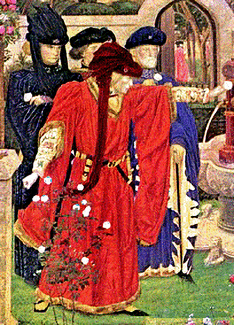
The opposing armies clashed at the town of St Albans. The Yorkists made two frontal assaults down the town's narrow streets against Lancastrian barricades, to no effect. The Earl of Warwick lead his troops through back lanes and gardens, to launch a surprise attack on Lancastrian troops in the Market Square. The Lancastrians were routed. Warwick then issued orders to shoot those guarding the king, Henry seems at this point in the battle to have been wounded by an arrow. The Lancastrians troops stationed at the barricades realised they were ouflanked and fled.
Henry VI was captured and escorted back to London by the victorious Yorkists. The leading Lancastrian Dukes of Somerset and Northumberland along with Lord Clifford were killed.
Northhampton, 10 July 1460
Margaret of Anjou, fiercely defensive of the rights of her son, Edward of Lancaster, the Prince of Wales, remained utterly determined to crush the Yorkist claim to the throne. She gathered an army to advance her son's cause and York, Salisbury and Warwick were forced into flight before her.
In response, the Duke of York marched his forces from his base at Ludlow but was intercepted by a Lancastrian army lead by Lord Audley. Attempts at negotiation between Warwick and the Lancastrians proved fruitless as Henry refused to admit Warwick to his presence. The ensuing battle outside the walls of Northampton proved a significant Yorkist victory, the Duke of Buckingham, the Earl of Shrewsbury and Lords Egremont and Beaumont were all killed whilst attempting to protect the king from the Yorkists closing on his tent. Henry was again captured and Margaret and her son were forced to flee.
Wakefield, 30 December 1460
The resolute Margaret of Anjou responded to this victory by raising a further army. York and his brother-in-law and ally Richard Neville, Earl of Salisbury advanced to meet the Queen. They defeated a Lancastrian advance guard lead by Andrew Trollope and arrived at Sandal Castle in Yorkshire where they planned to spend Christmas.
A large force of around 6,000, lead by the Duke of Somerset and Lord Clifford surrounded the castle. York impulsively led his army down from the castle and into a trap. Two large forces of the Lancastrian army, commanded by the Earl of Wiltshire and Lord Roos, emerged from nearby woods and the jaws of the trap snapped shut on the Yorkist leader. The Duke of York was killed in the ensuing slaughter. His son the Earl of Rutland was killed whilst in the course of escape, Salisbury was captured and executed. Their severed heads were displayed at York, that of York himself decorated in derision with a paper crown.
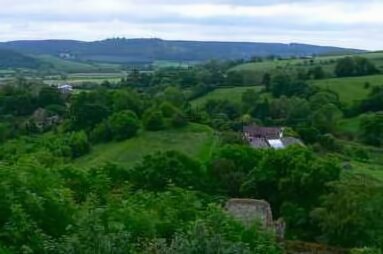
Mortimer's Cross, 2 February 1461
York's eldest son, Edward, Earl of March, took up the position of leader of the Yorkist cause. An efficient general, he presented as a formidable opponent to Margaret. Edward IV joined forces with the dead Salisbury's son, Richard Neville, Earl of Warwick, in London, determined to avenge his father's death.
Edward marched into Hereford to engage the Lancastrian lords, Jasper Tudor and the Earl of Wiltshire, who were routed at Mortimer's Cross. Before the battle, a complete parhelion appeared in the sky, from which phenomena it is believed, Edward adopted his badge of the Sun in Splendour. Jasper's father, Owen Tudor, was captured and beheaded after the battle.
Richard, Duke of York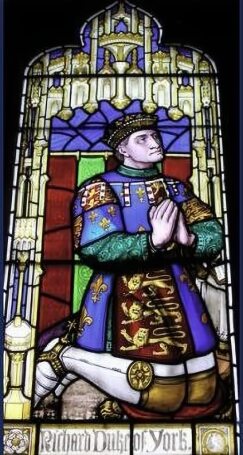
Second Battle of St. Albans, 17 February 1461
A large Lancastrian army proceeded towards London, who was met by the Earl of Warwick, with the king in his train at the town of St. Albans on Barnard's Heath. Elaborate defences of caltraps, spiked nets and various traps were set up in anticipation of the arrival of the Lancastrian army. However, the attack did not materialise as Warwick had envisaged. The Lancastrian vanguard entered St Albans from the direction of Dunstable and pursued the Yorkist rearguard in retreat from the town. The main body of the Yorkist army was then attacked from the flank and the rear.
Warwick marched west to join forces with the approaching Yorkist army under Edward, leaving London undefended. Terrified by tales of Lancastrian pillaging and looting, the citizens of London refused to open the gates, forcing the Lancastrians to withdraw north to Yorkshire.
Battle of Towton Palm Sunday, 29 March 1461
The Battle of Towton, a bitter blood bath was fought in a fierce snowstorm on a plateau between the villages of Towton and Saxton in Yorkshire. Both sides had amassed sizeable armies of around 50,000 each. Edward led the Yorkist centre, Warwick the right and Fauconberg the left. The Lancastrian army was led by the Duke of Somerset, who controlled the centre, the Earl of Northumberland commanding the right and the Duke of Exeter the left. The Lancastrian army occupied a good strategic position at the summit of the plateau.
The Yorkist archers, greatly aided by the wind direction, were able to shoot much further than their Lancastrian counterparts. Finally, the Lancastrians charged their opponents and ferocious hand to hand fighting ensued. Edward himself fought on foot. The Duke of Norfolk arrived on the scene with reinforcements ensuring a Yorkist victory.
The routed Lancastrians fled, Some of the worst slaughter took place at the aptly named Bloody Meadow, where it was reported men crossed the River Cock over the bodies of their fallen comrades. The dead littered the fields from Towton to Tadcaster. At Tadcaster, some Lancastrian troops made a stand but were slaughtered. The rout lasted throughout the night and into the morning. Towton proved to be the largest and bloodiest battle ever fought on English soil, with casualties reported to have been in excess of 28,000. Henry VI, Margaret of Anjou, and the Lancastrian Prince of Wales fled north to seek refuge in Scotland. The triumphant Earl of March was accepted as king and crowned as Edward IV at Westminster Abbey on 28 June 1461.
Hedgeley Moor, 25 April 1464
On his way to the border of Scotland to meet a group of envoys to discuss peace, John Neville, Lord Montague, brother of Warwick, whilst en route to Scotland, clashed with a Lancastrian force at Hedgeley Moor. The wings of the Lancastrian army was forced into flight and the remainder defeated.
Battle of Hexham, 14 May 1464
On his return from the Scottish border, Montague again met the Lancastrians forces at Hexham, which resulted in a further Yorkist victory. Many Lancastrian leaders were executed after the battle, severely limiting their effectiveness as a rival party for the crown
Battle of Edgecote Moor, 26 July 1469
King Edward IV's unpopular marriage to the greedy and grasping Elizabeth Woodville eventually succeeded in alienating Warwick and his brother George Plantagenet, Duke of Clarence. In 1469 in response to an uprising in Yorkshire Edward gathered an army and marched north, he was intercepted and defeated on the journey by a Lancastrian force. Warwick and Clarence had already landed in England from Calais to join the rebels under 'Robin of Redesdale'. Edward was captured and 'the Kingmaker 'Warwick assumed control of the country, albeit in his name.
Battle of Losecote Field, 12 March 1470
Under the ruse of putting down an uprising, Edward IV raised an army in 1470 and attacked Warwick's forces at Empingham. Victory went to the royal forces. The battle acquired its name of 'Losecoat Field' due to the haste in which the rebels shed their coats in flight. Warwick and Clarence fled to France, where they were encouraged by Louis XI to ally with the exiled Margaret of Anjou, Warwick married his younger daughter, Anne Neville, to Margaret's son, the Lancastrian Prince of Wales.
The Battle of Barnet, 14 April 1471
Warwick, returning from France, joined forces with his allies Montague, the Duke of Exeter and the Earl of Oxford at Coventry and marched toward London. Edward awaited them just north of the town of Barnet. A thick mist descended prior to the battle, obscuring sight of the enemy, resulting in both army's being incorrectly aligned, with their right wings were overlapping.
The royal army duly advanced, the right-wing outflanking Warwick's left. The same situation arose with the royal left wing, which was similarly outflanked and routed by Warwick's right, commanded by the Earl of Oxford, an excellent general. The King managed to deploy his reserve and attacked Warwick in the centre. Oxford, who had been engaged in the pursuit of the fleeing Yorkists, returned to the battle, due to the thick mist, Montague's men mistook Oxford's banner for the Yorkist sun in splendour and opened fire on them. Oxford's contingent fled and the rebels were routed. The mighty Warwick was killed fleeing the battlefield in an attempt to reach his horse.
Tewkesbury Abbey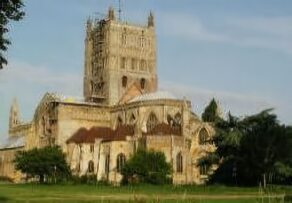
Tewkesbury, 4 May 1471
Margaret of Anjou and her son, Edward, Prince of Wales, landed in France on the eve of the Battle of Barnet to hear the disquieting news of the Yorkist victory at Barnet and her ally, Warwick's death. Edward pursued them as they marched to Wales to join forces with the staunch Lancastrian, Jasper Tudor, Earl of Pembroke and caught up with them at Tewkesbury, in Gloucestershire. The Prince of Wales and Lord Wenlock led the Lancastrian centre and the Earl of Devon, the left. Margaret retired to a nearby convent, to await the outcome of the battle.
Edward IV himself commanded the centre of the Yorkist army, his youngest brother, Richard, Duke of Gloucester, the left and William, Lord Hastings the right. Edward attacked at dawn, following an exchange of artillery fire, the Yorkists advanced at which Somerset attacked the flank of the Yorkist left. The Yorkist's responded by attacking Somerset's flank. Somerset himself attacked and slew the aged Wenlock, whom he frenziedly accused of not supporting him. The remainder of the Lancastrians panicked and fled, pursued into Tewkesbury by the exultant Yorkists. The Prince of Wales was either killed fleeing the battle or shortly thereafter. Lancastrians who sought sanctuary in Tewkesbury Abbey were dragged out and executed. The Lancastrian cause was now utterly decimated, Margaret, crushed at last by the death of her son, was taken prisoner and imprisoned in the Tower of London.
Boar badge of Richard III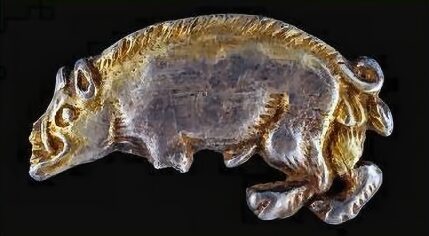
Bosworth, 22 August 1485
On the death of Edward IV, his young sons, Edward V and Richard, Duke of York. were imprisoned in the Tower of London, after which they were never again seen alive, and the throne was taken by his brother, who became Richard III. His right was challenged by Henry Tudor, Earl of Richmond, who claimed to be the heir of Lancaster.
Henry landed at Milford Haven in Wales on August 7, 1485, and Richard III advanced to meet him. The two armies eventually faced each other south of the village of Market Bosworth in Leicestershire. The ranks of the Yorkist army were infiltrated with treason. Lord Thomas Stanley and his brother Sir William positioned their armies to the sides of the battle and their timely intervention ensured a victory for Henry Tudor, who succeeded to the throne as Henry VII. Richard III was killed in battle, having refused to flee. Henry later married Edward IV's eldest daughter, Elizabeth of York.
An imposter arose to challenge the newly established Tudor regime in 1487. Lambert Simnel, who posed as Edward, Earl of Warwick along with his die-hard Yorkist supporters, including John de la Pole Earl of Lincoln, Richard III's appointed heir, planned an invasion of England. They were met by Henry VII's forces under the Earl of Oxford at East Stoke. Initially, the rebel army seemed to be gaining the upper hand, but after the arrival on the battlefield of Lancastrian reinforcements, they were eventually routed and Henry VII triumphant.
The Battle of Mortimer's Cross
A tour of Bosworth Battlefield
Edmund Beaufort, Duke of Somerset
Richard Neville, Earl of Salisbury
Richard NevilleWarwick 'the Kingmaker'
John NevilleMarquess of Montague
Edward V- the Princes in the Tower
Edward of Lancaster PreviousNext Edward, Earl of Warwick
